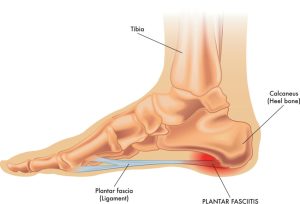What is plantar fasciitis?
As the name suggests, plantar fasciitis is inflammation of the plantar fascia — a tough, fibrous band of tissue that runs along the sole of the foot. Plantar fasciitis is one of the most common causes of heel pain. It commonly causes stabbing pain, especially with your first few steps in the morning or after being off your feet for a while. As you get up and move, the pain normally decreases. Eventually, it might return after long periods of standing or when you stand up after sitting. It is more common in runners and in people who are overweight.
What are the symptoms?
- Stabbing pain in the bottom of your foot near the heel
- The pain is usually the worst with the first few steps after a long sleep, long periods of standing or getting up from sitting
What are the causes?
Inflammation and pain in the fascia can be caused by:
- An increase in activity level (like starting a walking or running program)
- Structure or shape of the foot
- Surfaces on which you stand, walk or run
- Type of footwear
- The weight you carry
What are the risk factors?
Even though plantar fasciitis can develop without an obvious cause, some factors can increase your risk of developing this condition. These include:
- Age – Plantar fasciitis is most common in people between the ages of 40 and 60
- Certain types of exercise – Activities that place a lot of stress on your heel and attached tissues. For example, long-distance running, ballet dancing and aerobic dance can contribute to the onset of this condition
- Foot mechanics – Flat feet, a high arch or even an atypical pattern of walking can affect the way weight is distributed when you are in standing. Subsequently, this can put added stress on the plantar fascia
- Obesity – Excess weight can put extra stress on your plantar fascia
- Occupations that keep you on your feet – Commonly, factory workers, teachers and others who spend most of their work hours walking or standing on hard surfaces are at increased risk.
Plantar Fascitis and Physiotherapy:
1. Stretching and Physical Therapy
Stretching is one of the best treatments for plantar fasciitis. A physical therapist can show you stretching exercises that you can repeat at home several times a day. Along with stretching, the exercises can also strengthen your lower leg muscles, helping to stabilize your ankle.
2. Icing and Medication
Icing the sore spot on your foot several times a day may help with pain and inflammation. Additionally, your doctor may also recommend nonsteroidal anti-inflammatory medication.
3. Rest, Activity Modification and Orthotics
It helps to keep the weight and stress off your foot, at least partially, while your plantar fascia is healing. Your doctor may recommend a combination of treatments.
4. Shock Wave Therapy
This therapy is based on delivering low-energy or high-energy shock waves to a specific area. Then, the shock waves create microscopic trauma, which triggers a healing response from the body. This process is thought to help promote healing in the plantar fascia.
Our team of expert physiotherapists at PhysioNow are prepared to help you with your foot pain. They will help diagnose and guide you through a treatment to reduce pain and improve your quality of life. Book your first appointment with PhysioNow today!





Leave a Reply